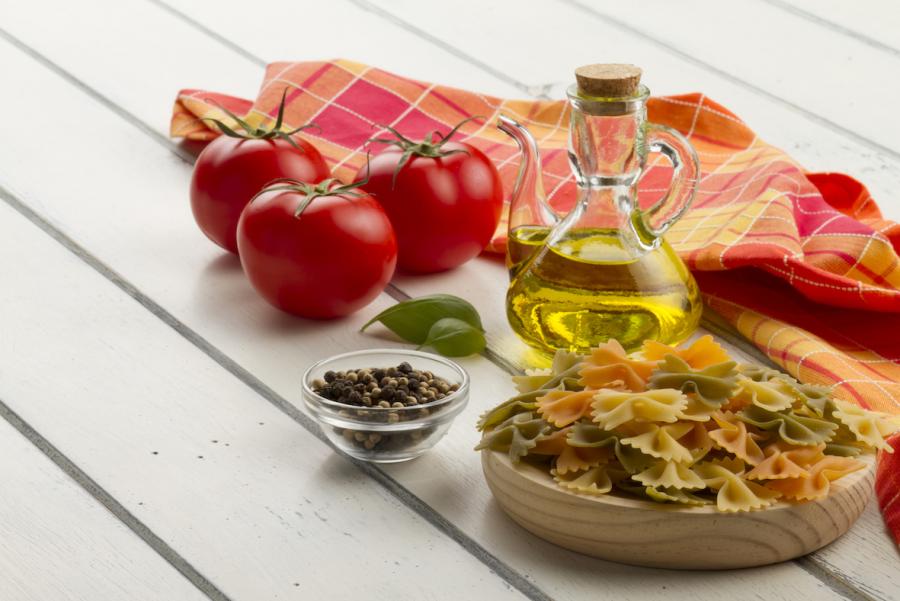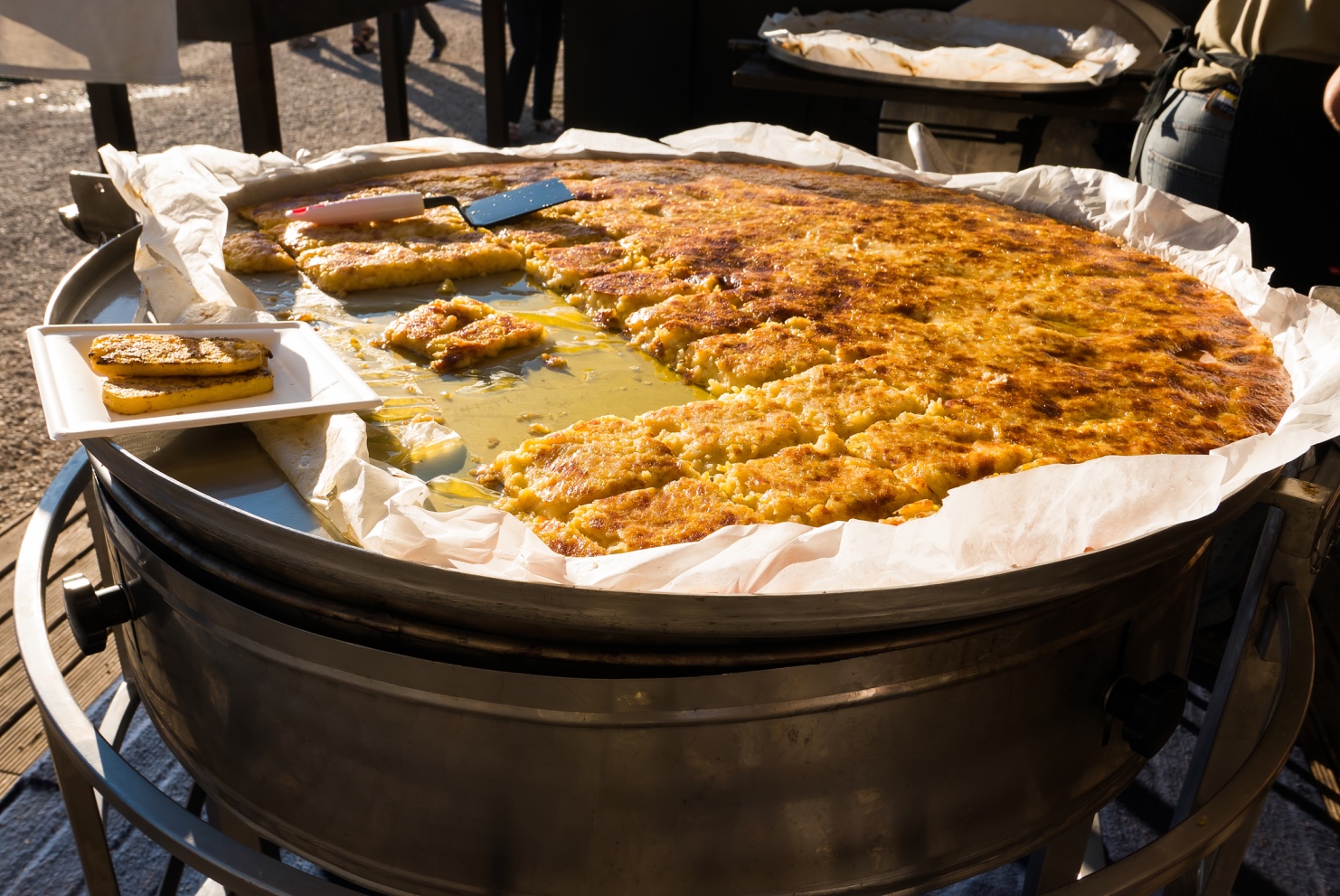What is the Difference Between All Those Names?
The “pressed” method means that no heat or chemical additives were used to extract the oil from the olives, which can alter and destroy the flavor and aroma of the oil and that a centrifuge was not used. This does not mean that the oil was pressed in an antique wooden press–most pressed oils are done using modern presses. Without adding heat to the processing, the olive oil also retains its full nutritional value.
“Virgin” (without the word “Extra”) olive oil has a slightly higher acidic level and does not meet the same requirements as “Extra Virgin” does.
Regular, or plainly labeled “olive oil” is a blend of slightly defective or low quality olives with much less flavor and color in the final oil produced.
“Light” olive oil has gone through even more processing techniques and contains little or no color or flavor. Once again, “Light” does not mean less calories. Oil is fat. Fat is high in calories. Period.
You also have to understand the basic culinary difference in the use of Extra Virgin versus other lesser grade olive oils. Extra Virgin oil is not used for cooking. It is used fresh… in salads, drizzled over pizza or steaks and pasta. You can drizzle it over crusty, toasted bread or cheese. Chefs use it to finish off a plate… to finish a soup or a stew. Extra Virgin olive oil has a very low smoke point… 320F as opposed to 420 degrees for a lesser graded olive oil. Basically, Extra Virgin burns too easily for cooking in.
Cooking Tip: If you are used to frying in olive oil, don’t waste you’re best Extra Virgin olive oil, but buy a higher quality “olive oil” grade to fry with… and to lower the smoke temperature, use half olive oil and half canola oil (a colorless, flavorless oil). You will have more success frying when using this olive/canola mix.
How Do I Find the Best Extra Virgin Oil?
To make sure you’re really getting a high quality Extra Virgin oil, look at the labeling carefully. Check to see if it lists the region in Italy, not just that it was imported from Italy. Producers of high quality olive oil are proud of their regions and will definitely say where their oil originated. You should also see the harvest date somewhere… or in the least, an expiration date, but keep in mind, the oil might have been harvested a year before the expiration date. The next thing to look for is the type of olive the oil was made from. You want to see one cultivar of olive named… cheaper oils use a blend from many types–usually of lower quality–so they won’t list all the cultivars used in the blend. You have to picture all the local olive growers bringing their olives to a regional production facility where their olives are graded and mixed with those of other growers. “Extra Virgin” from this type of operation will not be of high quality.
If you look at the label on the supermarket brands you’ll notice that most will saw “imported from Italy”, but then list a bunch of letter codes for the countries the oil or olives came from. For instance, one Colavita Extra Virgin that I have in my pantry lists Italy, Greece and Spain as the countries where the oil came from, even though it says imported from Italy. And even though it lists “Extra Virgin Olive Oil” as the only ingredient, I can guarantee that this was not from a “first cold pressing”… the oil is clear and fairly flavorless. You have no idea if your “Imported from Italy” oil was grown and produced there, grown and bottled in another country but shipped from Italy, was grown in another country with the oil produced in Italy, or merely just shipped from there. Remember, Italy is part of the Euro zone, and as such, it’s like saying a product was made or grown in one state in the U.S. while packaged and exported from another.
Another gallon bottle I have labeled plain “olive oil” is even more clear with a brighter color, is almost flavorless, comes from 5 different countries, and lists “a blend of olive oils and extra virgin oil” as the ingredients. Note that “extra virgin” is listed last which means that it’s the lesser ingredient–perhaps a little bit in large production runs to help add a hint of flavor and add validity by including a bit of Extra Virgin.
Now, about color…
Does the color of the oil matter? Yes and no. Olives harvested earlier in the season produce a greener oil because there is more chlorophyll in the fresher fruits. Olives harvested later will produce a more golden oil. Different cultivars of olives also can change the color of an oil. By the way, the dark colored green bottles do serve a somewhat good purpose too. They help prevent light exposure to the oil which can make it oxidize (and spoil) faster. It’s a two edged sword… it tends to hide the true color of the olive oil inside the bottle from the consumer, but can make the oil last a bit longer in storage. (Still, most olive oils when stored properly last up to a year anyway). Beware though, that some unscrupulous makers will put leaves into the olive mash to release chlorophyll which helps color the lesser quality oils.
Picture
What About the Flavor?
Flavors of olive oil are all over the place. They differ because of cultivar of olive, where they ares grown, how they’re processed, the methods used in storing the oil before it comes to your table… and of course, personal and cultural preferences. For instance, some cultures prefer a slightly musty flavor–something that most Westerners think is distasteful. It also depends on the variety of cultivar grown and the time of the harvest. Some olives are big, while others are small. Some have higher acidic flavors than others do. Tasting olives right from the trees in Puglia, we can tell you that they can be very acidic! Weather also plays a big part in the harvest time. And keep in mind, even the same tree can have many different colors of olives in varied degrees of ripeness… we saw this ourselves in Italy. Depending on the time the grower decides to collect the olives really affects the flavor of the resulting oil.
It’s best to think of olive oil–especially Extra Virgin–as a spice added to food to enhance the flavor. Olive oil types can be paired to foods, just the way wine is paired. For cooking, the lesser oils are better anyway due to their higher smoke point… I’d just recommend staying away from “extra light” because they might have remaining of true olive flavor. For Extra Virgin, read the labels and buy small bottles to experiment with. Find out what you like on various foods… pasta or salads versus fish or beef. A more delicate oil might go best on a white fleshed fish or salad… you might even like flavored oils for this… citrus, for example. I personally like more fruity flavors in my Extra Virgin for use on bruschetta or pizza.
The three flavor ranges of olive oil can be described as: delicate, medium, and robust. Fruity flavors tend to be more robust. This is not something that can be labeled, however. The flavor of olive oil can change from harvest to harvest in the same way a variety of wine can change from vintage to vintage. The best thing to do is start buying Extra Virgin oils–the best you can afford–tasting and deciding for yourself. Here’s a guide listing the cultivars of olives and the flavor profile category:
Delicate oil (made from arbequina, leccino, sevillano, taggiasca) is well suited for delicate fish.
Medium intensity oil (ascolana, manzanillo, mission) is fine for salad dressings, grilled vegetables, soups, sauces and poultry.
Robust oil (arbosana, frantoio, picholine) can be drizzled over steak with a spritz of lemon.































